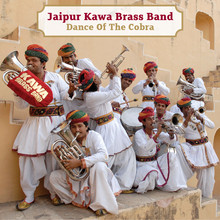 Alhoewel sinds de jaren ’70 de brass band cultuur in India steeds commerciëler wordt, lukt het de Jaipur Kawa Brass Band om onder leiding van (tabla speler) Hameed Khan Kawa, een energieke reputatie op te bouwen. Sinds 1995 zet het orkest een decennia lange blaas traditie voort en blinkt uit in improviserende virtuositeit. ‘Dance of the Cobra’ is hun tweede cd.
Alhoewel sinds de jaren ’70 de brass band cultuur in India steeds commerciëler wordt, lukt het de Jaipur Kawa Brass Band om onder leiding van (tabla speler) Hameed Khan Kawa, een energieke reputatie op te bouwen. Sinds 1995 zet het orkest een decennia lange blaas traditie voort en blinkt uit in improviserende virtuositeit. ‘Dance of the Cobra’ is hun tweede cd.
English version below
Het zijn de Engelsen die in 1757 de brass band cultuur in India introduceren. Tot 1850 waren het alleen deze West-Europeanen die in de kapellen musiceerden tijdens de zgn. ‘Band Nights’; een combinatie van receptie/dansavond & concert waar de mars zeer populair was. Later (vanaf 1880) voegen ook Indiase musici zich bij deze brass bands. Als in 1947 India onafhankelijk wordt, neemt de brass cultuur een vlucht en ontstaan er honderden blaas orkesten die hun geld verdienen tijdens lokale en geboorten feesten, begrafenissen en vooral bruiloften. Elk dorp of stad heeft een aantal orkesten: Delhi heeft er bijvoorbeeld zo’n negen honderd. Elk orkest heeft een kapelmeester die de artistieke leiding in handen heeft. In de ’70-er jaren wordt de kapelmeester aangevuld met een zakelijk leider. Een manager met weinig muziekkennis die zorgt voor drie optredens per dag tijdens het vijf maanden durende bruiloft seizoen. Alles moet zo goedkoop mogelijk waardoor kwaliteit vaak inferieur is.
De Jaipur Kawa Brass Band speelt op ‘Dance of the Cobra’ opzwepende muziek met duizelingwekkende ritmen die zeer belangrijk zijn en een stevige basis vormen voor deze zinderende muziek. Opvallende is het divers gebruik van de blazers: soms unisono (vette sound), solistisch (trompet of klarinet), dan weer aanvullend of meerstemmig. Een prachtige mix waarin we veelvuldig de mars horen zoals: ‘Gore Gore…’ en ‘Laal Laal Gaal…’ Bijzonder zijn de sitar en de accordeon, beiden te horen in één nummer. Net zoals de doedelzak, een geliefd instrument van de mashaq bands uit de 50-er jaren, met een revival in de jaren ’90. In het gezongen ‘Soniya Dil Da Mamla’ horen we naast een prachtige vrouwenstem ook de mondharp en de shehnai (soort hobo). De Jaipur Kawa Brass Band klinkt hecht, compact, gevarieerd en zelfverzekerd en bezweert met ‘Dance of the Cobra’ veel meer dan alleen die giftige slang.
English version
Although brass bands get more and more commercial since the ’70s, Hameed Khan Kawa built up on an energetic reputation with his Jaipur Kawa Brass Band. Since 1995 the orchestra proceed in improvising virtuosity. ‘Dance of the Cobra’ is their second album.
The English colonists introduced the brass culture in India in 1757. Until 1850 only the Indian West European musicians played in the so called ‘Band Nights’. A combination of a reception and dance evening with concert where you often hear the popular march. Later (from 1880) also the Indian musician joined the brass bands. When India got independent in 1947, the brass culture gets more popular under the Indian musicians and hundreds of brass bands earn their money at local parties, weddings, births and funerals. Each village or town has their own orchestra: Delhi for example about nine hundred. Each orchestra has its own artistic director who is responsible for the repertoire and arrangements. In the ’70’s a business director was added. A manager with less musical knowledge but good for three gigs a day in the five months wedding season, with cheap commitments and less quality.
The Jaipur Kawa Brass Band was established by Hameed Khan Kawa. He found the best musicians from Rajasthan and formed an eight musicians ensemble. The repertoire on ‘Dance of the Cobra’ insists of traditional Indian music with popular Bollywood melodies and Northern Indian music. The Jaipur Kawa Brass Band plays a dazzling kind of music with sparkling rhythms, very important for the soul of the music. Striking is the way by using the different blow instruments: unisono (big sound), solo parts (on trumpet or clarinet), complementary or in harmony. A beautiful mix in which we hear often the popular march: ‘Gore gore…’ en ‘Laal Laal Gaal…’ Special are the sitar and the accordion, both in one song. Like the bagpipes, a loved instrument in the mashaq bands form the fifties, with a ’90’s revival. In the song ‘Soniya Dil Da Mamla’ there is a wonderful women’s voice and the moutharp with the shehnai (kind of hautbois). ‘Dance of the Cobra’ sounds tight, compact, varied and self-assured and makes you dance like the poisonous snake.
- Jaipur Kawa Brass Band: ‘Dance of the Cobra’ (Riverboat/World Music Network/Music&Words)
© Mattie Poels.

Geen reacties